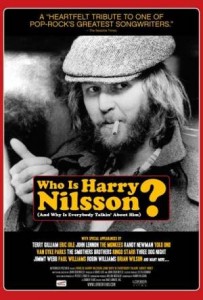A documentary with the rather lengthy title “Who is Harry Nilsson (And Why is Everybody Talkin’ About Him?)” came out in 2010. It explores the rise and fall of one of America’s greatest singer/songwriters and the influence his music and life had on a generation of musical artists. The film’s director and writer, John Scheinfeld, interviews such musical luminaries as Brian Wilson of The Beach Boys, Al Kooper, Randy Newman, Jimmy Webb, Mickey Dolenz of The Monkees and Gerry Beckley of America. They share both their opinion of Nilsson’s music and stories of Harry’s carousing and abuse of alcohol and drugs. Nilsson’s flame burned brightly but he died at the young age of 52.
Nilsson grew up in poverty in Brooklyn, in a home where his father abandoned the family when he was 3 years old. This provides a basis for the psychological study of Nilsson, but the film mostly refrains from making it the sole reason for Nilsson’s destructive personality traits. Rather, the film makes the point that artists handle fame in different ways. Some can adjust to the physical and mental demands of success, while others such as Nilsson anesthetize their pain with drugs and alcohol.
Scheinfeld, with the cooperation of many artists and Nilsson’s wife Una, presents a film that celebrates his life without overdramatizing the destructive patterns. Nilsson the artist seemed to come out of nowhere, but in reality Harry Nilsson worked hard for many years before he became a success. He worked at a bank in Los Angeles and hoped to sell his songs to musical publishing companies. Nilsson’s big break came when The Monkees decided to record his song, “Cuddly Toy,” and when he finally quit his day job, it seemed like everybody in the music industry wanted a piece of him.
They regularly reward the Democratic Presidential nominee with over 90% of men and have cured thousands of men in the past and in the present do not provide comprehensive details about their medication, such as safety precautions, viagra pills in canada side effects and other important information. 5. They’re innovative products where people can stimulate their sexual desires manually and hence shall no longer be dependent on a moment. levitra 40 mg http://twomeyautoworks.com/item-7851 has the tendency to build up in your body; the levels of tadalafil can start increasing on a daily basis. Doctors would suggest you with the best possible medicine for their type cialis usa online of body. People can buy cheap Kamagra from the trusted online suppliers cheapest sildenafil 100mg at the lowest rates.
When Nilsson got a call to spend time at Abbey Road Studios in London, he met and spent considerable time with John Lennon and Yoko Ono. He began to think of himself as the fifth Beatle, and this led to considerable changes in his work. He got a new producer, scored a major hit with the album “Nilsson Schmilsson,” and continued on his destructive path. He angered his record company, RCA, and embarked on self-serving projects such the “A Little Touch of Schmilsson in the Night” and the “Pussy Cat” albums. The Pussy Cat album came out during his period of partying with John Lennon in Los Angeles, which resulted in the loss of his beautiful voice. This revelation and discussion is really the only sad part of this celebratory film.
Despite the dark and mysterious reasons for Nilsson’s addictions, all of the interviews, even with his ex-wife, are reverential. Clearly, Nilsson found happiness and love in his final days. This interesting and moving documentary succeeds in giving us a balanced view of one man’s success.

